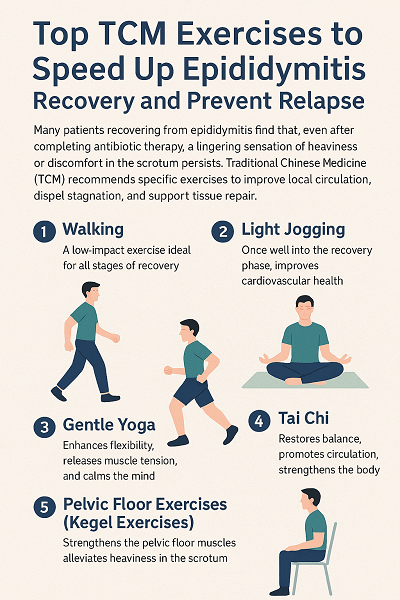Top TCM Exercises to Speed Up Epididymitis Recovery and Prevent Relapse
Many patients recovering from epididymitis find that, even after completing antibiotic therapy, a lingering sensation of heaviness or discomfort in the scrotum persists. Traditional Chinese Medicine (TCM) offers a unique approach to this issue, recommending gentle, targeted movement therapies to improve local circulation, dispel stagnation, and support tissue repair.

According to TCM theory, lingering symptoms during recovery are often due to qi and blood stagnation and blocked meridians. Scientific exercise—when guided by TCM principles—can activate these meridians, restore harmony in the body, and reduce the risk of recurrence.
Why Movement Matters After Acute Inflammation
Even after the acute phase of epididymitis subsides, patients may still suffer from local congestion and microcirculatory disruption. Although redness, swelling, or pain may no longer be present, prolonged sitting or fatigue can aggravate symptoms and even increase the risk of fibrosis. TCM-guided physical rehabilitation focuses on promoting qi and blood flow, strengthening the kidneys, and restoring meridian pathways. This gentle yet effective approach creates a favorable internal environment for tissue regeneration.
3 Principles for TCM-Based Exercise
1. Progress Gradually—Avoid Overexertion
In early recovery, gentle movement is key. Avoid high-impact activities like running, cycling, or anything that compresses the scrotal area. Gradually increase exercise intensity based on comfort level. A good rule of thumb: light sweating without fatigue.
2. Combine Movement and Stillness—Balance Yin and Yang
Practice traditional exercises like Baduanjin or Tai Chi, combined with static postures like standing meditation (zhan zhuang). Moving exercises promote circulation; static ones calm the mind and strengthen the kidneys. Together, they avoid overconsumption of energy and enhance systemic healing.
3. Focus on the Waist and Abdomen—Support the Root
The waist and abdomen are considered the "house of the kidneys" in TCM. Strengthening this area through targeted exercises improves blood supply to the epididymis indirectly. Complement this with local relaxation exercises to reduce scrotal pressure and discomfort.
5 Recommended Exercises to Support Recovery
1. Walking
A low-impact exercise ideal for all stages of recovery. Walking promotes circulation and metabolism without burdening the healing tissues. Aim for two walks daily (morning and evening), at a comfortable pace of 80–100 steps per minute. Long-term walking can help resolve inflammation and ease discomfort.
2. Light Jogging
Once you are well into the recovery phase, light jogging can improve cardiovascular health. However, it must be done with caution—avoid prolonged or fast runs that could trigger congestion in the epididymis. Try interval jogging: jog for 5 minutes, then walk briskly for 2 minutes, alternating for no more than 30 minutes per session, 3–4 times a week.
3. Gentle Yoga
Yoga enhances flexibility, releases muscle tension, and calms the mind. For epididymitis patients, choose restorative styles that focus on gentle stretching and mindful breathing. It helps regulate the nervous system and supports both physical and emotional recovery.
4. Tai Chi
With its slow, flowing movements, Tai Chi is ideal for restoring balance and promoting circulation. It enhances physical coordination and strengthens the body without stress. Especially suitable for older or physically weak patients, Tai Chi can greatly improve blood flow to the epididymal region.
5. Pelvic Floor Exercises (Kegel Exercises)
These exercises strengthen the pelvic floor muscles, enhance circulation to the genital region, and alleviate the sensation of heaviness in the scrotum. For best results, coordinate with breathing: contract the pelvic floor while inhaling, then slowly release with exhalation. Long-term practice supports recovery and helps prevent relapse.
Supporting Recovery with Herbal Solutions
While movement restores flow and balance, combining it with natural medicine can offer a more complete recovery strategy. Diuretic and Anti-inflammatory Pill, a patented herbal formula developed by Wuhan Dr. Lee's TCM Clinic, works internally to clear heat, reduce inflammation, and enhance blood circulation in the reproductive and urinary systems. It is particularly effective for chronic epididymitis, orchitis, and lingering discomfort after standard treatments.
When used alongside TCM-based rehabilitation exercises, this dual approach can speed up tissue repair, reduce recurrence, and support long-term urogenital health.
Conclusion
Recovery from epididymitis takes more than just rest. Movement—when guided by TCM principles—becomes a form of medicine. By integrating practices like Baduanjin, Tai Chi, and pelvic floor exercises into your daily life, and supporting your healing with the Diuretic and Anti-inflammatory Pill, you create the ideal environment for full recovery. Be patient, be consistent, and you'll reclaim your health naturally and effectively.



